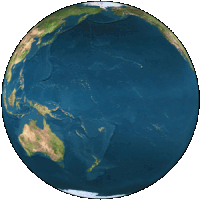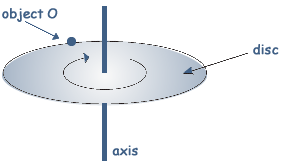Circular Motion - Multiple choice Q11. A fairground roundabout makes nine revolutions in one minute. What is the angular speed of the roundabout?
9 revolutions per minute = 9/60 per second. 1 rev = 2π radians ∴ angular speed = 2π x 9/60 = 0.94 rad s–1
Q12. The figure shows a smooth thin tube T through which passes a string with masses m and M attached to its ends. Initially the tube is moved so that the mass, m, travels in a horizontal circle of constant radius r, at constant speed, v. Which one of the following expressions is equal to M?
The tension in the string is due to the centripetal force of the mass = mv2/r This is balanced by the weight of the mass Mg ∴Mg = mv2/r so M = mv2/rg
Q13. What is the angular speed of a point on the Earth's equator?
Time for full rotation of 2π radians is 602 x 24 seconds in one second: 2π/86400 = 7.27 x 10-5 radians/second
Q14. For a particle moving in a circle with uniform speed, which one of the following statements is correct?
Q15. An object moving at constant speed in a circle experiences a force that is
It acts towards the centre of the circle - at right angles to the movement. Q16. A ball of mass m, which is fixed to the end of a light string of length l, is released from rest at X. It swings in a circular path, passing through the lowest point Y at speed v.
If the tension in the string at Y is T, which one of the following equations represents a correct application of Newton's laws of motion to the ball at Y?
The tension in the string pulls at the mass. The centripetal force of the mass's circular motion is provided by the tension in the string. If we ignore weight then: T = mv2/l When it is in the position shown in the digram, the weight of the mass also produces tension in the string so T = mv2/l + mg This rearranges to give solution C. Q17. A disc of diameter D is turning at a steady angular speed at frequency f about an axis through its centre.
What is the centripetal force on a small object O of mass m on the perimeter of the disc?
acceleration = ω2r = ω2D/2 and ω = 2πf So, a = 2 F = ma F= 2 Q18. What is the angular speed of a car wheel of diameter 0.400 m when the speed of the car
is 108 kmh–1 ?
One turn of wheel makes the car travel π x 0.400 m. Therefore the wheel turns: 108 x 103/ (π x 0.400) times in one hour and 108 x 103/ (π x 0.400 x 602) times in one second. One complete turn is 2π radians, therefore in one second it turns: 108 x 103 x 2π / (π x 0.400 x 602) = 216 x 103 / ( 0.400 x 602) = 150 rads - choice B
Q19. A bob of mass 0.50 kg is suspended from the end of a piece of string 0.45 m long. The bob is rotated in a vertical circle at a constant rate of 120 revolutions per minute.
What is the tension in the string when the bob is at the bottom of the circle?
The centripetal force of the mass's circular motion is provided by the tension in the string. If we ignore weight then: T = mv2/r
T = mv2/r + mg Time for full rotation is 1/120 minutes = 60/120 seconds =0.5 seconds So, in one second there are two revolutions the circle perimeter is 2πr = 0.9π ∴ v = 1.8π m/s T = 0.50 x (1.8π)2/0.45 + 0.5 x 9.81 T = (35.5 + 4.9) T = 40.4 N (Choice D)
|
Follow me...
|











